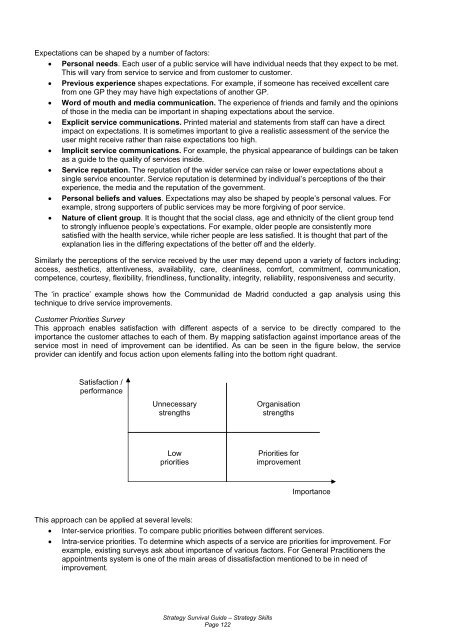Strategy Survival Guide
Strategy Survival Guide
Strategy Survival Guide
Create successful ePaper yourself
Turn your PDF publications into a flip-book with our unique Google optimized e-Paper software.
Expectations can be shaped by a number of factors:<br />
• Personal needs. Each user of a public service will have individual needs that they expect to be met.<br />
This will vary from service to service and from customer to customer.<br />
• Previous experience shapes expectations. For example, if someone has received excellent care<br />
from one GP they may have high expectations of another GP.<br />
• Word of mouth and media communication. The experience of friends and family and the opinions<br />
of those in the media can be important in shaping expectations about the service.<br />
• Explicit service communications. Printed material and statements from staff can have a direct<br />
impact on expectations. It is sometimes important to give a realistic assessment of the service the<br />
user might receive rather than raise expectations too high.<br />
• Implicit service communications. For example, the physical appearance of buildings can be taken<br />
as a guide to the quality of services inside.<br />
• Service reputation. The reputation of the wider service can raise or lower expectations about a<br />
single service encounter. Service reputation is determined by individual’s perceptions of the their<br />
experience, the media and the reputation of the government.<br />
• Personal beliefs and values. Expectations may also be shaped by people’s personal values. For<br />
example, strong supporters of public services may be more forgiving of poor service.<br />
• Nature of client group. It is thought that the social class, age and ethnicity of the client group tend<br />
to strongly influence people’s expectations. For example, older people are consistently more<br />
satisfied with the health service, while richer people are less satisfied. It is thought that part of the<br />
explanation lies in the differing expectations of the better off and the elderly.<br />
Similarly the perceptions of the service received by the user may depend upon a variety of factors including:<br />
access, aesthetics, attentiveness, availability, care, cleanliness, comfort, commitment, communication,<br />
competence, courtesy, flexibility, friendliness, functionality, integrity, reliability, responsiveness and security.<br />
The ‘in practice’ example shows how the Communidad de Madrid conducted a gap analysis using this<br />
technique to drive service improvements.<br />
Customer Priorities Survey<br />
This approach enables satisfaction with different aspects of a service to be directly compared to the<br />
importance the customer attaches to each of them. By mapping satisfaction against importance areas of the<br />
service most in need of improvement can be identified. As can be seen in the figure below, the service<br />
provider can identify and focus action upon elements falling into the bottom right quadrant.<br />
Satisfaction /<br />
performance<br />
Unnecessary<br />
strengths<br />
Organisation<br />
strengths<br />
Low<br />
priorities<br />
Priorities for<br />
improvement<br />
Importance<br />
This approach can be applied at several levels:<br />
• Inter-service priorities. To compare public priorities between different services.<br />
• Intra-service priorities. To determine which aspects of a service are priorities for improvement. For<br />
example, existing surveys ask about importance of various factors. For General Practitioners the<br />
appointments system is one of the main areas of dissatisfaction mentioned to be in need of<br />
improvement.<br />
<strong>Strategy</strong> <strong>Survival</strong> <strong>Guide</strong> – <strong>Strategy</strong> Skills<br />
Page 122
















